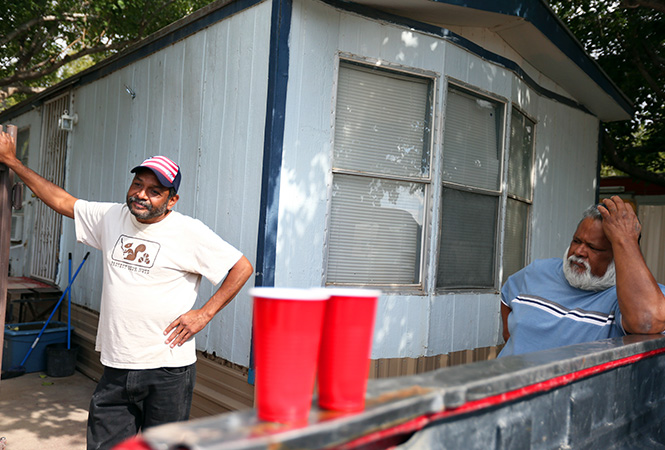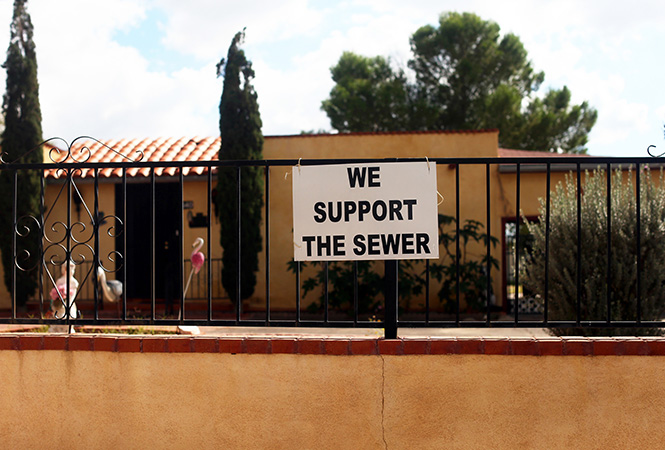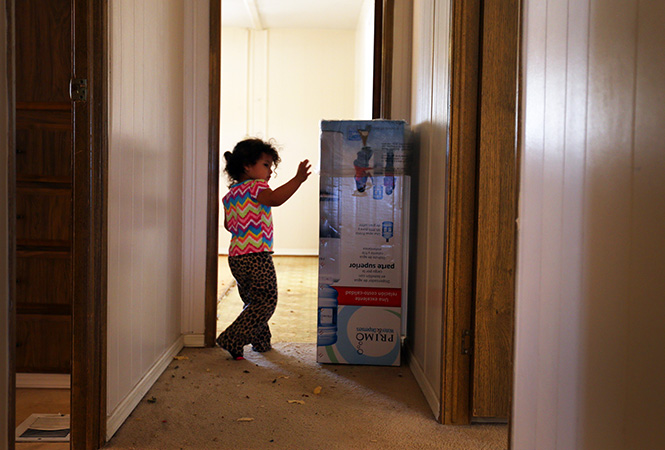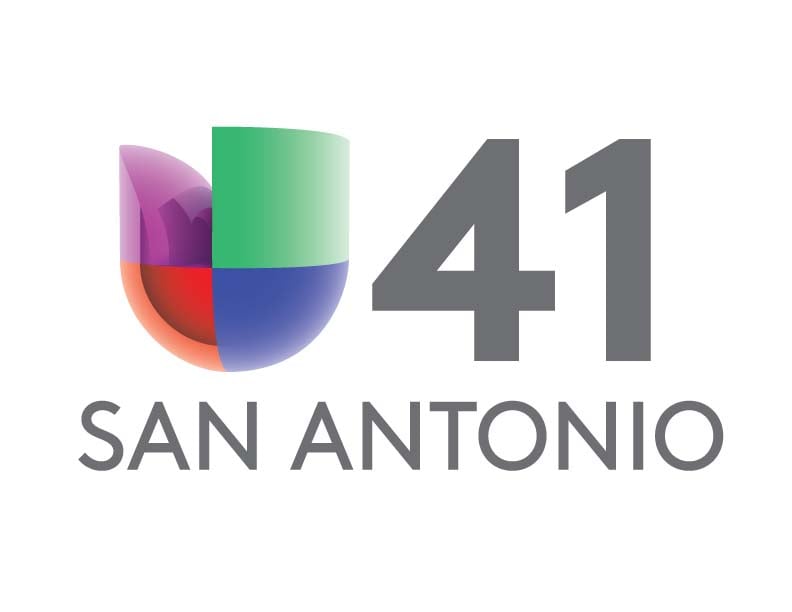
Safe water was within reach, but politics and entrenched interests undercut decades of work

Letters sent by schoolchildren to Vinton Mayor Madeleine Praino’s office urging her to improve the town’s water and sewer service. Photo by Jennifer Whitney.
VINTON — The letters, and the drawings, are heartbreaking.
“I want you to know that you are continuing to contaminate the water that we drink, and the water that we bathe in, and the water that we wash our dishes and our clothes with,” one schoolgirl, Fabiola, writes neatly in dark pencil. “And why are you doing this?”
In crayon beneath her plea for clean water, Fabiola drew a toilet with waste seeping underground into a family’s well.
Another letter, signed “Love Sophia,” says in Spanish, “We do not want to be sick anymore.”
A stack of these letters has been sitting on Vinton Mayor Madeleine Praino’s desk since 2012, when she received the bulk of them, though more have arrived since. That year, after a decades-long effort and amid high hopes, a plan to improve water and sewer services for the incorporated village of 2,000 people crumbled amid nasty City Council politics.

Vinton Mayor Madeleine Praino has led the efforts to connect the town to nearby El Paso’s cleaner and more reliable water and sewer system. Photo by Jennifer Whitney.
“We have constant calls from developers: When are you getting the water? When are you getting the sewer?” Praino said from her City Hall office last fall. But it was the letters from schoolchildren, initiated by elementary school teachers in Vinton, that really got to her, Praino says. “I was kind of shaken.”
For almost half a century, this community has lacked a public water supply. The Rio Grande runs through town, but is mostly dry, forcing residents to rely on a questionable patchwork of local, private water companies that draw from wells. Only a slice of the town is hooked to nearby El Paso’s water system.
And because there is no sewer service, most houses have septic tanks that aren’t maintained, so wastewater seeps into the groundwater pumped for drinking.
Vinton differs little from other border communities. A majority of its Hispanic population speaks Spanish at home, a third moved here from Mexico and almost a fifth live in poverty. A steel mill that has operated for more than 50 years dominates the town, and many of its streets are named after metals — Iron Road, Copper Road, Steel Road.

When a group of researchers and students from the University of Texas at El Paso came to town in December 2013, they confirmed what many had long feared: Vinton’s water supply is not safe.
In tap water samples from dozens of households, researchers found some with alarmingly high levels of arsenic and salts. Others tested positive for bacteria like E. coli. Health surveys of Vinton residents found rates of skin problems and gastrointestinal issues higher than in a similar, neighboring community that gets its water from El Paso.
Almost a third of the town reported frequent skin problems, which researchers say are caused by salty bath water that dries out skin and can cause rashes and infections. A third of the population also reported frequent stomach and abdominal problems. E. coli causes severe stomach cramps, diarrhea and vomiting, and can be life-threatening.
Humans process arsenic “pretty quickly,” and Bill Hargrove, a professor and lead investigator of the Vinton study, says he worries especially about the long-term effects on children and the elderly. Ingesting arsenic can cause sore throats, nausea and vomiting, but one of the gravest concerns is an increased risk of cancer, according to the federal Centers for Disease Control and Prevention.
That has become Arturo González’s most acute worry. After moving to town more than 13 years ago, González, an ironworker who lives in a trailer with his 12-year-old son, drank the tap water without questioning it.
That stopped after a university researcher knocked on his door.
“We don’t use it anymore for drinking or cooking or nothing,” González says. “UTEP said it’ll give you cancer if you drink the water.”

Arturo González, left, and his brother, Samuel, stopped drinking the tap water in Vinton after a group of researchers and students at the University of Texas at El Paso found that the town’s water supply is not safe to drink and could be putting residents’ health at risk. Photo by Jennifer Whitney.
González goes to the store twice a month to buy several five-gallon drums of filtered water. He still pays $45 a month for running water, and says he’d gladly pay more to make it clean and safe.
That’s how many others feel in this town. Vinton’s population has doubled since 1990, but the town hasn’t shared in the economic development that has seen shiny malls and department stores spring up just outside its borders.
The water is not only foul, but often doesn’t flow at all. Many fire hydrants don’t work, and outages are common. In the summer of 2013, residents in one part of town lost water service for days in hundred-degree weather.
“Is this unique? I’m afraid, in Texas, it is not very unique,” Hargrove says. “There are many communities, especially in the border region, who face this same situation.”
And a solution is so painfully close.
A Failed Plan
While other communities without drinkable water are in rural, isolated areas with few options, Vinton has long had one. Engineers and scientists have recommended for decades that the town connect to nearby El Paso’s cleaner and more reliable water and sewer system. That’s what some of its neighbors have done.
In 2012, Vinton was ready to do just that: build about 21 miles of pipeline to bring in water from El Paso, and new storage tanks to hold it. Fifteen years of planning, design and applications for tens of millions of dollars in state and federal funds were almost completed. But then everything fell apart.
In March of that year, three City Council members voted against connecting to El Paso’s sewer system. Juvencia Rios-Ontiveros, Martha Garcia and María Medina had long opposed the project, claiming property taxes and water bills would rise too high.
A few months later, on the eve of a key deadline to apply for more funds to make the connection, the three women didn’t show up for a council meeting. Without a quorum to vote on submitting the application, Vinton had to abandon all the money.
“Their main goal was to stop government,” Praino says. “It was very painful.” The town had been unable to pass a budget that year because of a similar deadlock.
In an interview, Rios-Ontiveros called criticism of her “nothing but lies and innuendos.” Garcia and Medina could not be reached for comment.
Polling showed that more than 80 percent of the town favored the project. And the community was furious. “This deadlock is not only politically unhealthy, but more so is getting to be a physical health concern,” wrote the El Paso Times in a scathing editorial. “We agree that the citizens of Vinton have a right to clean, running water.”
Vitriol against the three council members was so high that two citizens filed a lawsuit against them, which ended in a settlement. The state Legislature also stepped in, changing Texas law in 2013 so that incorporated villages like Vinton can recall council members between regular elections.
State Rep. Joe Moody, an El Paso Democrat, sponsored the recall legislation. Politics can become the stumbling block for many small border communities trying to supplant entrenched private water providers, he says.
These communities “don’t have any real power to do anything to give them some control, some standard, for their communities,” Moody says of the power struggle between municipal government and private water providers. “A lot of people in small communities are looking for relief.”
Praino says she’ll never know for sure why the three former councilwomen were so opposed to the project. But “to me personally, it was a political issue more than anything else,” she says.
Rios-Ontiveros, a former Vinton mayor who challenged Praino in several mayoral elections, claims Praino misled the public about the water project.
Because the town is mostly served by private water suppliers, she points out, before piping in water from El Paso, “you first have to buy out those water systems.”
True, Praino acknowledges, and it’s unknown how much that will cost. But she and others believe that Vinton’s private water suppliers were partly responsible for killing the project for fear of losing business. “It was easy to figure out that they felt threatened,” Praino says.
Private Interests Also Failing
Some of Vinton’s private suppliers, including the one Praino uses, already deal with serious water contamination issues.
Hillside Water Works — which also serves González, the ironworker — pulls groundwater that is naturally tainted with arsenic. For the past few years, state and federal regulators have cited and fined Hillside for selling water with dangerously high arsenic levels and failing to tell customers about the health risks of drinking it. Sandra Richter, the owner of Hillside, did not respond to several phone calls seeking comment. But Praino says she has been told it would easily cost Hillside hundreds of thousands of dollars to properly remove arsenic from the drinking water it produces.
And those cost issues wouldn’t completely go away simply by connecting to El Paso city water. At least $40 million will be needed for the water and sewer projects — millions more than would have been needed just a few years ago, as construction costs have skyrocketed — and not all of that will be paid for by grants.
“We can’t get involved in the politics of a community. It was frustrating because there’s obviously a real need there.”
— J.T. O’Brien, project manager for Border Environment Cooperation Commission
In addition, it may cost hundreds of dollars for individual homes to hook up to the public water system, and as much as thousands of dollars for businesses. Praino says she will not have a definite number until more funding applications have been accepted, but says she hopes grants will offset those costs.
“I’m here to tell you, there’s not going to be one business in Vinton that’s going to be able to afford the entire hookup without some kind of assistance,” says Iris Sims, who owns a water well for a small mobile home park in Vinton and has lived there since 1977.
Records show that in 2010, residents served by Sims’ well were asked to boil their water for almost two weeks, and regulators have cited the water system for more recent problems.
Sims says she trusts the tap water the well produces, but she’d be willing to give it up. “I’d love to have city water. It would relieve me of a lot of work,” she says —but only if costs aren’t too high.
Karl Schneider, who manages several other water supply companies in town, would say little before hanging up the phone. Asked if he supported Vinton’s bid to connect to El Paso’s water and sewer systems, he said he didn’t want to talk about it.
“The village of Vinton is doing some things that they shouldn’t be doing, and I don’t want to get involved in it,” Schneider says. “They’re just making up stories that aren’t true.”
Schneider defended the water his companies are supplying. The state has not cited those companies for any major problems in the past several years.

A sign declaring support of a decades-long effort by Vinton to connect to nearby El Paso’s water and sewer system. Crumbling septic tanks in town are causing harmful bacteria to seep into residents’ drinking water sources. Photo by Jennifer Whitney.
Struggling to Move Forward
After two elections, Vinton’s current council supports the water and sewer projects. But the town has to start all over again, and will need millions of dollars more than it did before because construction costs have risen rapidly in the past few years.
“These council members have done damage to future efforts,” Moody says. “Even if the new council [members] are working to move the project forward, that effect is going to be felt for years.”
Praino’s staff recently asked the state for a loan of several million dollars and is waiting to hear back. But the ultra-low interest rates the state has offered in the past may not pan out this time, because the Legislature so far hasn’t budgeted for that.
A grant of about $500,000 from the Border Environment Cooperation Commission, previously reserved for Vinton, is also off the table. After sitting on the money for three years while Vinton’s council fought, the commission awarded it to someone else.
Federal lawmakers used to give out hundreds of millions of dollars in funding for such projects, and the commission’s job is to help border communities spend the money properly. But there’s almost no money left for projects like Vinton’s.
“We can’t get involved in the politics of a community,” says J.T. O’Brien, a commission project manager. “It was frustrating because there’s obviously a real need there. It wasn’t canceled for technical reasons — it was canceled for reasons internal to the community.”
Even if Vinton manages to secure funding, the town’s private water suppliers would still have to agree to a public buyout, and no one knows how much money they will ask for.
Two years after the El Paso project crumbled, simple but poignant white signs that read “WE WANT WATER” or “WE SUPPORT THE SEWER” line fences and rest against windows throughout the town.

Two-year-old Debbie Adame plays with the box her family’s water filter and dispenser came in. Her mother, Virginia (not pictured), says it was one of their first purchases after moving into their new home because the family does not trust the tap water. Photo by Jennifer Whitney.
There isn’t a sign in front of Virginia Adame’s house, which she recently bought despite the water problems so she can stay near her parents. But she is holding on to hope that the town will eventually connect to El Paso’s water system.
Spinning her daughter, Debbie, in her arms in their nearly empty living room, Adame says she’s worried about how the water will affect the 2-year-old’s health. Like other children, Debbie used to put her mouth against the faucet in their tub and swallow water during her bath, but Adame now warns her not to do that.
“That’s the first thing I told my husband we needed to get,” she says, pointing to the $99 water filter and dispenser sitting in her dining room. The family does not drink tap water, and they use filtered water to cook with and to brush their teeth.
“I don’t want her drinking water that’s going to affect her 10 years from now,” Adame says. “Or maybe even before.”
Disclosure: The University of Texas at El Paso was a corporate sponsor of The Texas Tribune in 2012. A complete list of Tribune donors and sponsors can be viewed here.
This project was crowdfunded via Beacon Reader. To review donors to the project, click here.
Contributors
This website was designed and developed by Becca Aaronson, Emily Albracht and Ben Hasson.






